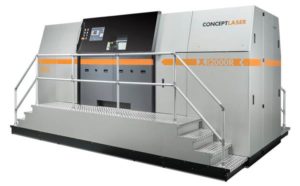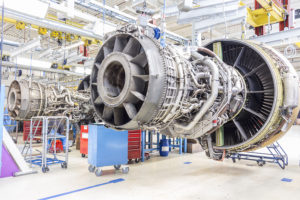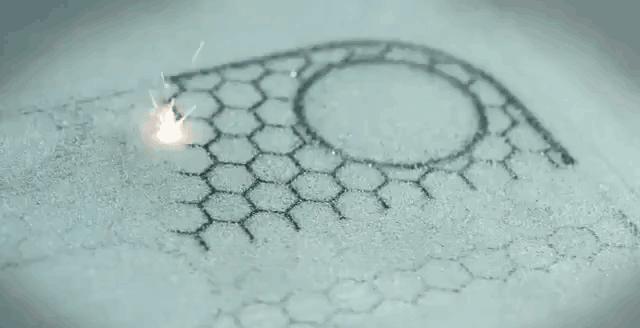If you’re captivated by the possibilities of 3-D printing, you’re certainly not alone. Manufacturers, engineers, and tech-savvy consumers are using additive manufacturing to create everything from toys to prosthetics and even food. However, the size and functionality of goods they can develop using traditional 3-D printers with plastic and liquid materials is limited.
That’s why a recent announcement from GE Additive is so exciting. Those inside this new 3-D printing-focused branch of GE are building the world’s largest laser-powered additive manufacturing machine that will be capable of building metal parts up to one cubic meter in size.
How it works
While more common 3-D printers use nozzles to squirt liquid into specific shapes, laser additive manufacturing can form parts out of metal. Additive machines use laser beams to fuse together fine layers of powdered metal, ranging from titanium to aluminum and beyond.
This method opens the door for users to develop larger, higher-wear components and parts — at lower costs. It’s particularly beneficial for those in the aviation industry, where insiders have been increasingly reliant on additive manufacturing methods to streamline the machine tooling process of their traditionally complex parts.
Additive manufacturing in action
One example is a jet engine fuel nozzle GE engineers developed. Using laser additive manufacturing, their engineering team was able to reduce 20 separate parts into one, reduce the weight of the nozzle by 25%, and improve durability five times.
“In the design of jet engines, complexity used to be expensive. But additive allows you to get sophisticated and reduces costs at the same time,” says Vice President and General Manager of GE Additive Mohammad Ehteshami in the GE Reports interview. “This is an engineer’s dream. I never imagined that this would be possible.”
And — most impressive — this feat was nearly a decade ago. Since then, GE engineers and those with other organizations have made huge strides in streamlining additive printing technologies for mass production. GE Additive’s newest equipment exemplifies this with size capabilities unlike anything else on the market.
Why bigger is better
 The largest, most advanced laser-powered 3-D printer available today is from Concept Laser, which GE acquired a majority stake of in 2016. The Concept Laser X LINE 2000R has a build volume of 0.8 meters by 0.4 meters by 0.5 meters, which GE will surpass once GE Additive engineers get their newest printer to market.
The largest, most advanced laser-powered 3-D printer available today is from Concept Laser, which GE acquired a majority stake of in 2016. The Concept Laser X LINE 2000R has a build volume of 0.8 meters by 0.4 meters by 0.5 meters, which GE will surpass once GE Additive engineers get their newest printer to market.
In fact, the engineers at GE and Concept Laser are working together to get this behemoth new machine ready, and once it is, you can expect to see a lot of excitement. Beta machines should be rolling out for customers by the end of 2017, and GE insiders expect a production model to be available for purchase in 2018.
What does this mean for you?
Although this machine was designed with the aviation industry in mind, Ehteshami says in the GE Reports article, “GE Is Building The World’s Largest ‘Additive’ Machine For 3D Printing Metals,” that it will be a valuable asset to a variety of other markets as well.
 “The machine will 3D print aviation parts suitable for making jet engine structural components and parts for single-aisle aircraft,” he said. “It will also be applicable for manufacturers in the automotive, power, and oil and gas industries.”
“The machine will 3D print aviation parts suitable for making jet engine structural components and parts for single-aisle aircraft,” he said. “It will also be applicable for manufacturers in the automotive, power, and oil and gas industries.”
With such enhanced capabilities and greater accessibility to this technology, it’s no surprise that laser additive manufacturing — and 3-D printing in general — are changing the manufacturing landscape. So much so, in fact, that GE professionals are banking on this technology to revolutionize manufacturing and bolster their bottom line. According to the GE Reports article, “An Epiphany Of Disruption: GE Additive Chief Explains How 3D Printing Will Upend Manufacturing,” GE Chairman and CEO Jeff Immelt announced a lofty 2020 goal to reach $1 billion in revenue from additive equipment and services.
As GE leaders and those with other organizations aggressively make and market their 3-D printing devices, it’s safe to say you’ll likely be seeing more laser additive manufacturing equipment soon. And that could be a very good thing for those in many facilities. As the technology continues to get bigger, better, and more available, the manufacturing possibilities — and cost savings — are truly endless.
